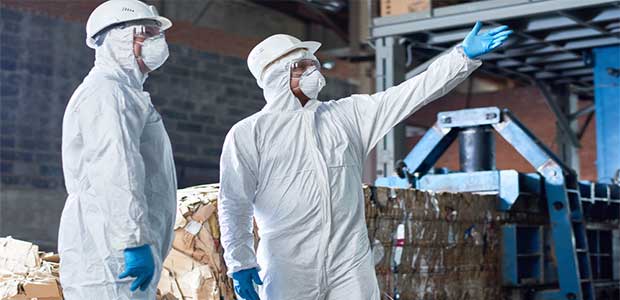
Materials Handling Training Throughout the Facility
Safely managing hazardous materials isn’t just a series of tasks for the crew at the receiving dock to complete.
- By Karen D. Hamel
- Sep 01, 2019
Safely managing hazardous materials isn’t just a series of tasks for the crew at the receiving dock to complete. Recognizing every area where hazardous materials are handled, stored, used, transported and collected is the first step in creating trainings that minimize risk and promote safe work practices throughout the facility.
Just as technicians in a quality control lab perform different job functions and work with chemicals differently than the engineers in a product development area, their risk levels also vary. Tailoring training to reflect those specific risks will help to promote the safe handling of hazardous materials in every area of a facility.
Receiving Areas
Raw materials can arrive in many different forms, each presenting its own special handling needs. Materials may arrive in bulk and be transferred directly to storage tanks. Drums and pails may be shrink-wrapped on skids. Boxes may contain several small containers.
For the most part, however, receiving crews don’t see or directly handle the actual materials inside each of the containers. They typically move intact containers from the receiving dock to another area. After doing this all day, every day without incident; it can be easy to forget or minimize the potential for harm in the event of a container failing or a transfer hose breaking.
Like all other employees, receiving crews need to have hazard communication training to be taught about the hazardous chemicals that they work with each day. This training should also include instruction that prepares them to know what to do when a trailer arrives with something unknown leaking out of the back of it. They also need to know what is expected of them when they graze or puncture a container that’s been placed in a congested unloading area.
Warehouse and Storage Areas
Just because a container has been put on a rack or in a cabinet and no one has touched it doesn’t mean that it won’t leak. Sometimes packages are damaged during transportation, but the damage isn’t evident at first. Other times, materials are forgotten or are not properly rotated, and they pass their expiration date, causing the container or package to degrade and allowing the contents to leak.
In addition to the mess a leaky container causes, the spilled contents can present additional safety problems if they leak onto something that is incompatible. Establishing dedicated areas for each raw material that is stored and communicating the need for product segregation with employees during trainings reduces the risk of incompatible materials being stored on top of, below or near each other.
Manufacturing and Processing Areas
Employees in manufacturing and processing areas have more potential to come into direct contact with hazardous materials than employees in other areas of a facility. Chances are, in addition to hazard communication training, they also have a series of additional safety trainings that work together to support written work processes and procedures to minimize the chance of incidents.
Part of handling hazardous materials safely in manufacturing areas is preventing those materials from entering the environment. If it is not included in standard operating procedures, training may include the need to segregate hazardous wastes and keep it in closed containers as well as preventing spills of hazardous materials from entering drains that lead to waterways. Training may also include instruction on special packaging or labeling that is required for finished products.
Laboratories
Like employees in manufacturing areas, lab technicians have the potential for direct contact with hazardous materials. Although it is typically on a smaller scale than in manufacturing, lab employees may work with all the chemicals found in the manufacturing process as well as chemicals that are unique to the laboratory.
The OSHA Laboratory Standard (29 CFR 1910.1450) specifies that laboratory workers must be taught about the physical and chemical hazards in their work area, measures to take to protect themselves, and methods that they are to use to detect the presence or release of a chemical. They must also be taught about the details of the facility’s chemical hygiene plan.
Lobbies and Security
It is easy to overlook the need to train receptionists and security personnel on the need to handle hazardous materials safely because they are not typically involved with receiving, operations or shipping. However, when there is an emergency, they are usually among the first to be called to make evacuation announcements.
Including these personnel as well as buildings and grounds crews and other service areas in hazard communication trainings fosters a better understanding of potential hazards. It can also facilitate dialogue between different areas that promotes better site safety during emergencies.
Shipping
If all has gone well, the finished products being shipped to customers should be packaged in containers that are in good condition. This helps to minimize the chance of exposure for anyone in the shipping crew.
If any product or waste being shipped contains a hazardous material that is subject to DOT hazardous materials shipping regulations, employees involved in the shipping process may be considered hazmat employees (40 CFR 172.704) and need additional DOT hazmat employee training. This training helps them to recognize shipments that need special packaging, labeling and marking to comply with DOT shipping requirements.
Following hazardous materials through their life cycle at the facility from the time they arrive as a raw material to the time when they leave as a product or a waste helps to ensure that the correct procedures are put in place to handle them safely during each step of the process. Targeting training efforts on the specific needs within each area helps employees to focus on the specific actions they need to take to handle hazardous materials safety.
This article originally appeared in the September 2019 issue of Occupational Health & Safety.